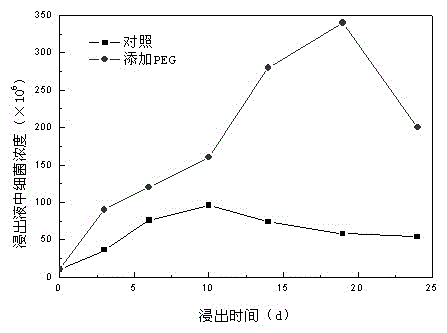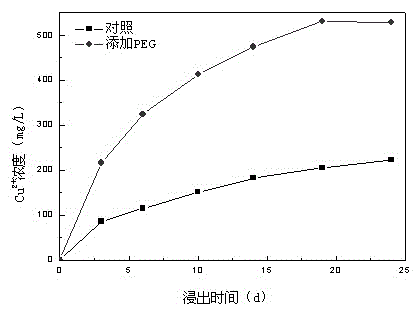A kind of method for adding nonionic surfactant to promote chalcopyrite bioleaching
A non-ionic surface, bioleaching technology, applied in the field of hydrometallurgy, can solve the problems of low leaching rate and slow leaching speed, and achieve the effects of low price, stable performance and broad application prospects
- Summary
- Abstract
- Description
- Claims
- Application Information
AI Technical Summary
Problems solved by technology
Method used
Image
Examples
Embodiment 1
[0032] (1) Crushing and grinding the chalcopyrite ore sample to -0.074mm, and then sterilizing with ultraviolet light, as a leaching sample;
[0033] (2) Thiobacillus ferrooxidans was grown to the logarithmic phase in 9K medium, the culture solution was filtered to remove the alum precipitate, and the bacteria were collected by centrifugation for 15 minutes (10000r / min) as the leaching inoculum.
[0034] (3) Place the leaching sample in the sterilized 9K basic salt solution, the concentration of the leaching sample in the solution is 1g / 100mL, insert Thiobacillus ferrooxidans, and adjust the initial bacterial concentration to 1×10 7 pcs / mL, then add polyethylene glycol, the amount of polyethylene glycol added is 30mg / L, and dilute sulfuric acid is used to adjust the initial pH of leaching to 1.8;
[0035] (4) Under the conditions of 30°C and 150r / min, place the above leachate in an air bath constant temperature oscillator for oscillating leaching for 24 days, use a hemocytomet...
Embodiment 2
[0045] (1) Crushing and grinding the chalcopyrite ore sample to -0.074mm, and then sterilizing with ultraviolet light, as a leaching sample;
[0046] (2) Thiobacillus ferrooxidans was grown to the logarithmic phase in 9K medium, the culture solution was filtered to remove the alum precipitate, and the bacteria were collected by centrifugation for 15 minutes (10000r / min) as the leaching inoculum.
[0047] (3) Place the leaching sample in the sterilized 9K basic salt solution, the concentration of the leaching sample in the solution is 2g / 100mL, insert Thiobacillus ferrooxidans, and adjust the initial bacterial concentration to 3×10 7 each / mL, then add polyethylene glycol, the amount of polyethylene glycol added is 50mg / L, and dilute sulfuric acid is used to adjust the initial pH of leaching to 2.5;
[0048] (4) Under the conditions of 25°C and 180r / min, place the above leaching solution in an air bath constant temperature oscillator for oscillating leaching for 24 days, use a h...
Embodiment 3
[0056] (1) Crushing and grinding the chalcopyrite ore sample to -0.074mm, and then sterilizing with ultraviolet light, as a leaching sample;
[0057] (2) Thiobacillus ferrooxidans was grown to the logarithmic phase in 9K medium, the culture solution was filtered to remove the alum precipitate, and the bacteria were collected by centrifugation for 15 minutes (10000r / min) as the leaching inoculum.
[0058] (3) Place the leaching sample in the sterilized 9K basic salt solution, the concentration of the leaching sample in the solution is 1g / 100mL, insert Thiobacillus ferrooxidans, and adjust the initial bacterial concentration to 5×10 7 pcs / mL, add 9g / L Fe 2+ , then add polyethylene glycol, the amount of polyethylene glycol added is 90mg / L, and dilute sulfuric acid is used to adjust the initial pH of leaching to 3.0;
[0059] (3) Under the conditions of 35°C and 160r / min, place the above-mentioned leachate in an air bath constant temperature oscillator and oscillate for 18 days. ...
PUM
 Login to View More
Login to View More Abstract
Description
Claims
Application Information
 Login to View More
Login to View More - R&D
- Intellectual Property
- Life Sciences
- Materials
- Tech Scout
- Unparalleled Data Quality
- Higher Quality Content
- 60% Fewer Hallucinations
Browse by: Latest US Patents, China's latest patents, Technical Efficacy Thesaurus, Application Domain, Technology Topic, Popular Technical Reports.
© 2025 PatSnap. All rights reserved.Legal|Privacy policy|Modern Slavery Act Transparency Statement|Sitemap|About US| Contact US: help@patsnap.com



